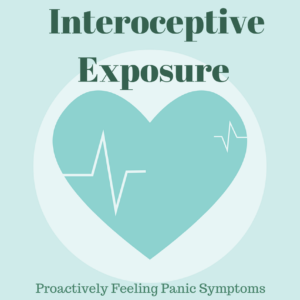
In a previous post we talked about learning to tolerate strong physical sensations. When we have a strong sensation it’s valuable to sit with the feeling rather than avoiding it or fighting it. It provides evidence that a feeling alone is not dangerous.
Interoceptive work takes us to the next level. It’s proactive feeling. Instead of waiting for those scenarios where we might start feeling panic symptoms (heart rate increased, numbness, dizziness, shortness of breath, trembling,…) we intentionally create those sensations.
Does this sound a little counterintuitive? Why would we want to force ourselves to feel the very symptoms we avoid?
It all goes back to the take-home message about strong physical sensations. A feeling alone is not dangerous. But we can train ourselves to believe that strong physical sensations are dangerous and need to be avoided. If we have enough experiences where strong physical sensations occurred alongside unhelpful thinking (catastrophizing and overestimation of danger) or traumas, then those become tied up. A strong physical sensation becomes something to avoid.
We need to retrain ourselves in identifying, tolerating, and accepting strong physical sensations. It is intelligent to avoid and fight strong physical sensations when the scenario is dangerous. But we know these feelings alone are not dangerous and it ends up being unhelpful to avoid all strong physical sensations.
Interoceptive work includes identifying how our panic is manifest (what physical sensations) and then coming up with simple exercises to practice feeling those sensations. These exercises are not intended to be physically painful or harmful to a person’s health. They’re simple things like spinning in a chair until dizzy or breathing quickly in and out to feel a little lightheaded. It may be valuable to talk to a doctor before doing interoceptive work to make sure nothing is contraindicated for your person’s health.
Overall interoceptive work helps us by getting us used to strong feelings. If we’re more comfortable with the feeling itself, then when the feeling comes in a real-life scenario we don’t feel as nervous or anxious, and we’re less likely to avoid or catastrophize a non-dangerous situation.
